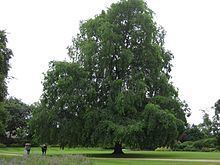Cultivar 'Wentworthii Pendula' | Origin Unknown | |
 | ||
Similar Ulmus 'Den Haag', Ulmus × hollandica 'Vegeta', Ulmus 'Purpurea', Ulmus 'Louis van Houtte', Ulmus minor 'Argenteo‑Variegata' | ||
Ulmus 'Wentworthii Pendula', also spelt 'Wendworthii Pendula', commonly known as the Wentworth Elm, is a cultivar with a distinctive weeping habit which appears to have been introduced to cultivation towards the end of the 19th century. Little is known of its history; indeed, the tree is not mentioned in either Elwes & Henry's or Bean's classic works on British trees. The earliest known references are Dutch and German, the first by de Vos in 1890. At about the same time, the tree was offered for sale by the Späth nursery of Berlin, suggesting it was, in spite of its very English name, of German origin (see Etymology). de Vos writing in 1889 states that the supplement to volume 1 includes entries announced since the main volume in 1887 putting the date of introduction between 1887 and 1889. De Vos dismissed the tree as '..one we can do without. As ornamentals, U. pitteurs pendula {:Zelkova × verschaffeltii} and U. suberosa pendula {:U. 'Lombartsii'} are far prettier, and as a (weeping) arbor U. montana pendula {:U. glabra 'Horizontalis'} is by far the most beautiful.'
Contents
The only known references to the botanical provenance of the Wentworth Elm are two found in the Ulmus 'Names' list of the Royal Botanic Garden Edinburgh, where it is identified as a hybrid of the Huntingdon Elm Ulmus × hollandica 'Vegeta' and Plot's Elm Ulmus minor 'Plotii' (RBGE ref. no. 32931). However, given the tree's assumed origin in continental Europe, it is difficult to reconcile this hybrid conjecture with the fact that 'Plotii' was never known to have been grown beyond the UK.
At Kew, Melville dismissed the tree there labelled Ulmus × hollandica 'Wentworthii' as simply U. × vegeta (the lower branches of open-grown Huntingdon elms can also be pendulous), though Wentworth differs in form, leaf and bark from true Huntingdon (see Description below). While Richens and Rackham noted that examples of pendulous Ulmus × hollandica occur in the East Anglian hybridization zone, 'Wentworthii Pendula' is the only known large weeping-elm cultivar, pendulous also from upper branches, dating from the 19th century.
Description
A tall, conspicuously pendulous tree, bell-shaped when young, domed when older. The outer branchlets hang in long 'curtains', showing the 'bones' above the foliage rather like Ulmus glabra 'Horizontalis', with large Huntingdon-type leaves, but more deeply toothed and some up to 17 centimetres (7 in) long. The upper leaf surface is glossy and very sparsely hairy. The petiole at <5 mm is shorter than that of Huntingdon. The bark of mature trees is shallowly fissured, unlike the deeply fissured, often 'latticed' bark of Huntingdon. The tightly-clustered, apetalous wind-pollinated flowers are bright red, and appear in early spring. The seed is displaced towards the apex of the samara.
Pests and diseases
The tree is susceptible to Dutch elm disease (DED).
Cultivation
'Wentworthii Pendula' is extremely rare in cultivation; and does not feature in the UK National Elm Collection held by Brighton & Hove City Council. The specimens held at Kew Gardens and the Royal Botanic Garden Edinburgh succumbed to DED towards the end of the 20th century. However, in 2016 two old plantings elsewhere in Edinburgh (see Notable Trees below) were discovered, and are the only survivors known worldwide. Exported to North America, the tree featured in the 1902 catalogue of the 'Bobbink and Atkins' nursery, Rutherford, New Jersey. The tree is not known to have been introduced to Australasia.
Notable trees
Two old Wentworth Elms, with girths over 3 metres (9.8 ft), believed to have been planted c.1909, stand in the gardens of Holyrood Palace, Edinburgh (2016), on the main lawn to the east of the palace. Almost certainly two of the three specimens supplied to the RBGE by Späth in 1902, the taller is about 30 metres (98 ft) in height; the shorter was lightly pruned c.2015. A third tree at Holyrood Palace was felled in 2008 due to Dutch Elm Disease and a ring count indicated an origin of approximately 1905. Despite the dearth of textbook descriptions, the trees were confidently identified as 'Wentworthii Pendula' in a RBGE survey (2016), because their leaves and branchlets match old photographs of the type and because no other large weeping hybrid elm appears in the cultivar lists of the time. As was the case with the 'Wentworthii Pendula' at the RBGE, their lower branchlets 'routinely touch the ground' and are kept trimmed. The origin of this specimen, a much younger tree acquired in 1974 but killed by DED in 1996, is recorded only as 'Wiseman', possibly the Wiseman Nursery at Elgin, Moray.
Etymology
The tree is possibly named for Wentworth Woodhouse, the largest Classical house in Britain, or the architect of its grounds, Charles Watson-Wentworth, 2nd Marquess of Rockingham, or for the nearby Wentworth Castle. However, there is no recorded association of the tree with the estate and it may, in view of its predominant German association, have been named for Thomas Wentworth, 1st Earl of Strafford (1672–1739), Queen Anne's ambassador to the Prussian court, a much esteemed figure in Berlin during the wars with Louis XIV of France.
There is also a rare weeping ash cultivar called Wentworth, Fraxinus excelsior 'Pendula Wentworthii', though it is not known whether the name is related. Regarding the ash, Koch suggested in 1872 that 'Wentworth' may have been a corruption of 'Hepworth', the name of the vicar in Gamlingay on whose land the original 'Pendula Wentworthii' ash tree grew in the middle of the eighteenth century. The fact that the Wentworth ash appeared in print before the Wentworth elm may suggest a marketing decision of late 19th century nurseries to apply the same name to a not dissimilar tree.
